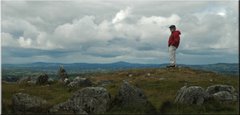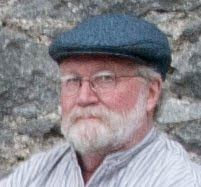 (Above: a lion guards the entrance to San Francisco's Legion of Honor art museum.)
(Above: a lion guards the entrance to San Francisco's Legion of Honor art museum.)Click on any picture to see a higher-resolution version.
One of the really cool things about being the head of one's own department in academia is that you get to schedule classes. If you're sufficiently selfish, that means that you can schedule yourself in such a way that you don't have any Friday classes, and, if a particular Friday has no committee meetings (or socialist cabal plotting sessions to overthrow liberty as it's known in North America, whatever), then you can say WOO-HOO!! on that Friday and run away with your wife to San Francisco, AKA "Oakland's Disneyland."
So, that's what we did on Friday, April 27th. We scuttled our way out of the San Lorenzo Valley, a rustic, rural, down-home, country sort of place, and drove up north about 75 minutes to the posh and swank city of San Francisco -- where one of us was born and the other lived and worked for two decades, and where our dear friend, Lucile, lives. And we went to an art museum, the Legion of Honor, which backs up against the Pacific Ocean near the
Golden Gate Bridge. All three of us (Mr. and Mrs. Fort and Lucile) have been there many, many times before... enough to know that the exhibits are ever-changing and ever-fascinating.
The main attraction today was a display of early-20th century jewelry. Lucile and Diane loved it, I appreciated it, and no photos were allowed.
After viewing that exhibit, we wandered around the grounds:
 "The Russian Bride's Attire" by Konstantin Makovsky, 1887, a small part of the museum's permanent collection. I have been attracted by the work's colors and understated contrast on my every visit to the museum, but this is the first time I've had the photographic wherewithal to capture some of what its presence brings to the viewer. Hope it works for you!
"The Russian Bride's Attire" by Konstantin Makovsky, 1887, a small part of the museum's permanent collection. I have been attracted by the work's colors and understated contrast on my every visit to the museum, but this is the first time I've had the photographic wherewithal to capture some of what its presence brings to the viewer. Hope it works for you! A bust of Voltaire by Jean-Antoine Houdon, 1781. I just love that expression, and I may use a cropped version of this bust as my avatar sometime.
A bust of Voltaire by Jean-Antoine Houdon, 1781. I just love that expression, and I may use a cropped version of this bust as my avatar sometime. On an earlier visit to the Legion of Honor, Diane and I had searched for paintings in which classic King Charles Spaniels (the precursors of our "Cavalier" King Charles Spaniels, Jax and Emma) could be seen. This is one of them, Gabriel Metsu's "Woman Playing the Viola da Gamba", in which a little dog, upon further inspection...
On an earlier visit to the Legion of Honor, Diane and I had searched for paintings in which classic King Charles Spaniels (the precursors of our "Cavalier" King Charles Spaniels, Jax and Emma) could be seen. This is one of them, Gabriel Metsu's "Woman Playing the Viola da Gamba", in which a little dog, upon further inspection... Our dear friend Lucile, who accompanies us on most of our forays into San Francisco, lives on Mount Davidson (a peak named after a 19th century astronomer and geodicist and the person most responsible for convincing James Lick to will his fortune to astronomy rather than self-aggrandizement, but I digress...) Above is her welcoming front staircase.
Our dear friend Lucile, who accompanies us on most of our forays into San Francisco, lives on Mount Davidson (a peak named after a 19th century astronomer and geodicist and the person most responsible for convincing James Lick to will his fortune to astronomy rather than self-aggrandizement, but I digress...) Above is her welcoming front staircase. Lucile's home has been undergoing much renovation, restoration, and re-invigoration for several years now, and a major figure in that effort has been Kevin, a contractor and artist. Kevin does major remodeling... and outstanding portraits! Above is Kevin's rendition of Lucile's wonderful pair of Oriental Shorthair cats, Teri and Blue.
Lucile's home has been undergoing much renovation, restoration, and re-invigoration for several years now, and a major figure in that effort has been Kevin, a contractor and artist. Kevin does major remodeling... and outstanding portraits! Above is Kevin's rendition of Lucile's wonderful pair of Oriental Shorthair cats, Teri and Blue. Across the street from Lucile's house, a pair of terriers keep an active eye on the neighborhood.
Across the street from Lucile's house, a pair of terriers keep an active eye on the neighborhood.We left home in the late morning, arrived back home in the early evening, and marveled all the way about how lucky we are to live in the midst of a forest that is so close to a vibrant center of culture. I'm not sure where else we could feed 12 chickens in the morning and, 90 minutes later, be in a museum whose entry surrounds us with Rodin works... and provides the jaw-dropping external scenery of the Golden Gate.
Life is good, sometimes, really, really good.






































